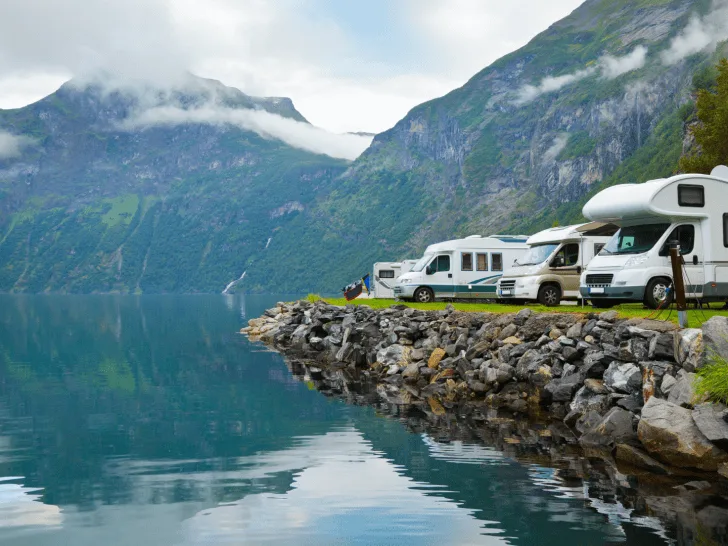RVs aren’t just for retired people! There has been a huge boom of families purchasing RVs in recent years. Many couples are choosing to begin their families in their 30s and 40s and the current median age for a first time buyer is now 41. But the questions remains- with all the different types of RVs out there, which RV types are best for your family? We aim to help you solve that puzzle!
According to RVshare’s 2022 Travel Trends Report, 70% of millennial travelers said they were planning to take an RV trip that year and 53% of travelers said they were likely to consider renting an RV for a future trip. Funny enough, 2022 also happened to be the year when my family officially caught the RV bug.
After a couple years of trying out different options on road trips, my husband and I purchased our first RV this year. We opted for a Ford Transit Van which was converted by Colorado Campervans. There were many options that went into that decision but ultimately, we were primarily concerned about getting a vehicle that could fit in our driveway while comfortably sleeping four.
I highly encourage you to rent several different RV options before buying. One of the best ways to do this is by booking through a rental site like RVshare.com. They have the largest selection of RV rentals in the US, ranging from luxury motorhomes to travel trailers, at a variety of price points.
Renting RVs will allow you to road trip in a few different models so you can really get a fill for what you like, don’t like, and the ammenities that are most important to you.
Types of RVs- 6 Different Options to Consider
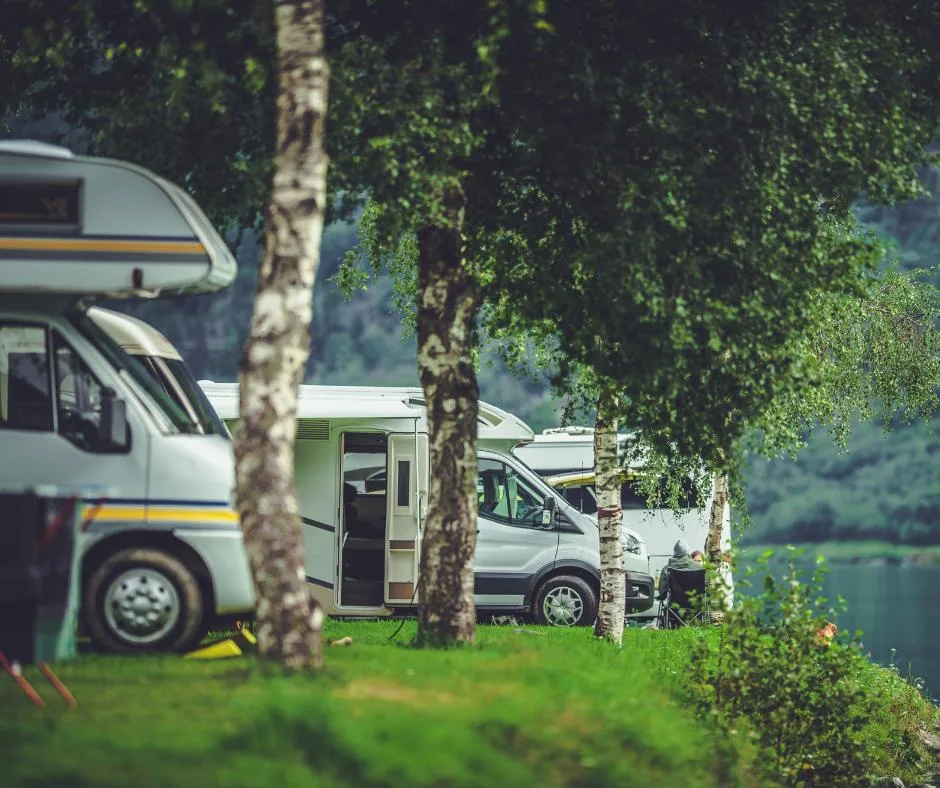
Recently, I took part in a summit at the San Diego Metro KOA Resort which was put on by GO RVing. They invited members of the RV industry to meet with journalists so that we could better understand the different types of RVs out there and learn about current trends in the industry.
I learned SO MUCH during the summit, especially about the different types of RVs out there and the huge range of price points. There is truly something for everyone.
Here is breakdown of some of the different types of RVs on the market, along with details on the model that I experienced (as well as video tours). When I talk about price, keep in mind I am referring to pricing on a brand new vehicle. The resale RV market is huge and prices can be much lower depending on the age of the vehicle and mileage.
Class B Motor Home
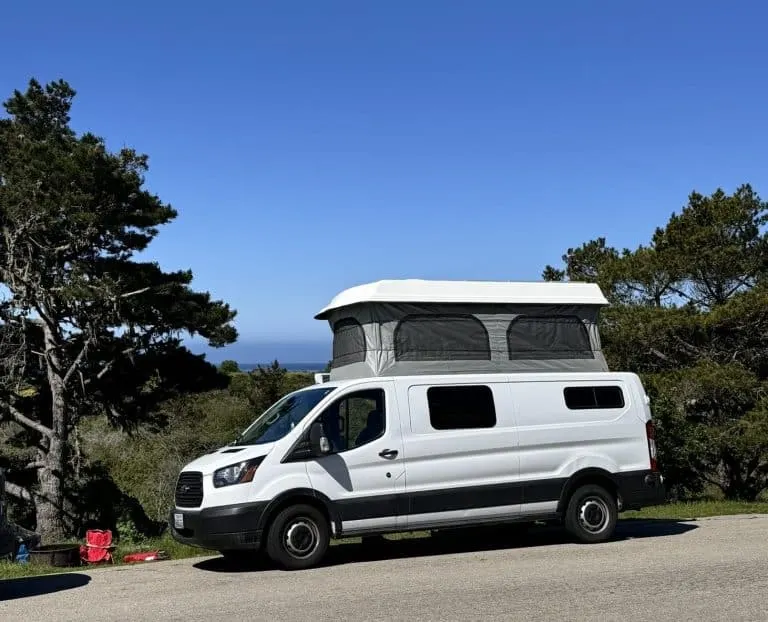
Class B motorhomes are more commonly known as camper vans. They are built on a van chassis and basically manuever like a full size van would. Some are available with pop ups for added sleeping space and have 4WD so that they can go offroad. They are typically 19-26 feet in length and range in price from about $85,000 to $300,000 new.
I own a converted Ford Transit. Many of the camper vans out there are built on a Ford Transit, Mercedes Sprinter, or a Dodge Ram Promaaster chassis. Lots of pop up are manual and pop up in a triangle shape.
My family is very tall so we really needed a full pop up, and I much prefer the mechanically operated pop up that Colorado Campervans offer becuase it is easier for me to do on my own when I am not traveling with my husband.
Due to our height (my husband is 6’5″ and my son is 6’4″), we found that the bathrooms in a Class B morohome were simply too small for us, so we opted not to get one. We instead have a portable, collapsible toilet and an outdoor shower on the back of our vehicle. We plan on upgrading it to be propane heated in the future. If you are smaller people, a bathroom with a shower would be nice to have.
There are lots of kitchen and storage configurations out there. Having a fridge and cooktop are definitely key. A sink is nice as well. We have a bed that converts to table on the lower level. Swivel seats up front are great features to consider. Always, always go for as much clever stoage as you can.
When considering a campervan, you will also want to think about length. Many tent sites operated by the National Park Service or State Parks have maximum lengths of 20 feet. It is nice to be able to fit in those spots but you do have sacrifice space inside your vehicle in order to do it.
Pros of a Class B Motorhome:
- Easy to drive and park. Driving this type of vehicle is a lot like driving a full size van or truck. Depending on length you may be able to park this vehicle in your driveway.
- Access to more campsites. The shorter length will allow you to camp in smaller campgrounds that longer RVs are not permitted in .
- The gas mileage of a Class B is typically better than a Class C because the vehicle is lighter.
Cons of a Class B Motorhome:
- The living space is much more compact than in most other types of RVs.
- Some may not have bathrooms or have very small bathrooms.
- The seating and sleeping capacity is smaller. Many Class Bs are made for two people but you can find some that sleep and seat 4 like we did. Many times this involves a pop top roof.
The Class B that I toured at the summit was the Entegra Launch Coach Class B. Entegra is owned by THOR Industries, one of the biggest players in the RV market.
It is the most luxurious model in this line of vehicles with a rear garage area, drop-down overhead bunk, integrated kitchen pull outs, bathroom with shower, and the Starlink Satellite Internet System as well as solar panels to help you go off grid while still saying connected. This vehicle is built on the Mercedes-Benz AWD Sprinter van chassis.
This loaded vehicle begins at around $230,000 new.
Back East? Here are our picks for the best East Coast Camping Destinations.
Class C Motorhome
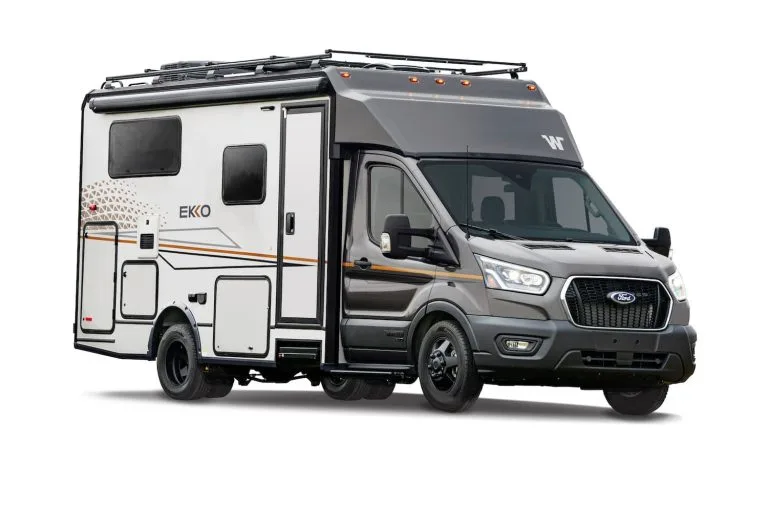
Class C Motorhomes are built on van or truck chassis and typically 20-35 feet in length. These are the most commonly seen motorhomes on the road (like those Cruise America RVs) and are typically 20-30 feet long. Most sleep about 4 – 8 people. Think of them as a step up from a campervan.
Pros of a Class C Motorhome:
- Easy to drive than many other types of RVs because they are built on a truck or van chassis.
- No special vehicle needed for towing.
- Smaller size gets you into more campsites
- They are generally more cost effective and and fuel-efficient than Class A motorhomes.
Cons of a Class C Motorhome:
- Much more expensive than a travel trailer because you are basically buying a truck that has been coverted into a motorhome.
- You will need RV parking or storage.
- Smaller living space than a Class A motorhome.
The first Class C that I toured was the Winnebago Ekko Transit. At only 23 feet in length, it packs quite a bit of functionality into a small space. Like my campervan, it runs on a Ford Transit chassis (albeit a few feet longer) and has AWD. There is also an uption to upgrade to a Mercedes Sprinter chassis.
One perk is the pass-through gear garage which is large enough to store bicycles, inflatable kayaks and other outdoor gear. Up top there are three solar panels that charge while driving, allowing you to be pretty energy independent while camping.
There are four seats, an ability to sleep four, a dry/wet bath which combines the space for a toilet and shower, a microwave, two-burner cook top, fridge, sink, table, and plenty of storage. The use of space is well done.
Prices for this vehicle begins at around $215,000.
The other Class C Truck Camper that I toured was the Dyanamax Series Isata 5 with the Extreme Package. It is built on a Ram 5500 SLT 4×4 truck chassis with turbo diesel. This bad boy has 360 horsepower and is built for 4×4 off-road Rving.
The Extreme Package includes a lifted chassis for more road clearance, aggressive 40” tires with blackout wheels, and Super-Single rear wheels to improve off-road performance. This particular vehicle also features dual llithium batteries, 950 watts of solar, dual-pane windows, enhanced insulation, and an auxiliary 12V heater in the utility bay with a temperature sensor.
The floorplan is luxurious with a queen bed in the rear slide out; living room slide out; full kitchen gas range, microwave, and fridge; a dinette, sofa, and full bath with shower, toilet, and sink.
It was awarded the 2024 RV Business Top Motorhome Debut of the Year. Dynamax is a division of Forest River.The suggested retail price for suped up model is $372,822.50.
Need road trip inspiration? Check out our incredible Utah National Parks Road Trip Itinerary.
Travel Trailers
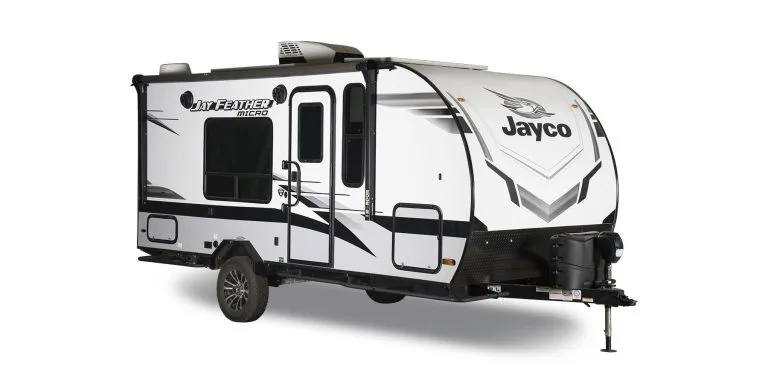
Travel Trailers are the most popular RV out there, in part because they tend to be the most affordable option. These trailers are towed by another vehicle. The vehicle’s needed towing capacity varies based on the size and weight of the trailer, but many SUVs and trucks can be used to tow travel trailers.
The downside of the Travel Trailer is that the total length of the vehicles you are driving is often bigger than it would be in a small Class C. The length of Travel Trailers varies widely- from a tiny 8 foot tear drop to a “everything including the kitchen sink” 40 foot behemoth.
As you can imagine, cost varies widely as well. You can get a little pop-up trailer for just over $10K new while the bigger trailers with all the bells and whistles will run you $150K.
Pros of a Travel Trailer:
- Travel Trailers are generally more affordable than motorhomes.
- They have lower maintenance and repair costs since they do not have an engine.
- They can be detached from the tow vehicle, allowing you to use your vehicle for local trips without having to move your entire living quarters from the campsite.
- Travel Trailers can be towed by a variety of vehicles such as SUVs, trucks, and even large cars, depending on the size and weight of the trailer.
- Many newer models have easy-to-use leveling systems and stabilizers, making setup at the campsite simple.
- They are easier to store than large Class A motorhomes and can often be stored in driveways.
Cons of a Travel Trailer:
- Towing a trailer can be challenging and intimidating, especially for those new to towing.
- Travel trailers are more susceptible to sway and wind effects compared to fifth wheels, which are generally more stable.
- They require a vehicle with adequate towing capacity, which can be an additional cost if you don’t already own one.
The Travel Trailer that I checked out was the Jaco Feather Micro. It is the lightest travel trailer that Jayco offers and can be towed by most mid-sized tow vehicle. Jayco is another brand owned by Thor. Prices begin at about $37,000.
There are a few different floorplan options for this model, but they all weigh less than 5,000lbs and can sleep up to 8 people. They feature beds, coaches, kitchens with stoves and microwaves, bathrooms with showers, and many other perks of a motor home, but at a lesser cost.
There is a griddle attached for outside cooking and even off-road tires to help you get more places. It is a nice step up from tent camping and quite affordable if you have a towing vehicle already and a place to store the trailer.
Fifth Wheel RV
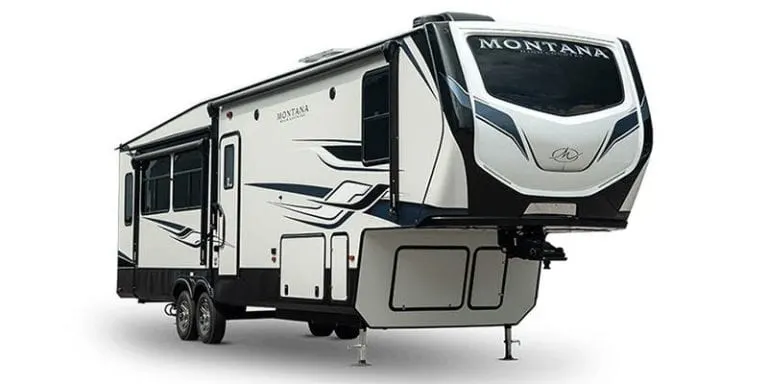
A fifth wheel RV is a towable trailer that is hitched into the bed of a pickup truck using a special “fifth wheel” hitch. This hitch connects to a hitching mechanism mounted in the truck bed and provides a more stable and secure towing experience compared to conventional bumper-pulled travel trailers.
They can often have a higher ceiling and more living space than some other types of RVS, and there is typically sleeping space above the trucks bed thanks to its bi-level design. There are distinct living areas like you would find in a motorhome, including bedrooms, living rooms, and kitchens.
Pros of a Fifth Wheel RV:
- Fifth-wheel trailers typically have spacious interiors with multiple slide-outs, increasing the living space.
- They typically feature full kitchens, large bathrooms, and comfortable sleeping areas so things don’t feel cramped and feel more like staying in a home.
- The hitch design provides better stability and control while towing, reducing sway and making them safer to tow. It also allows you to detach your vehicle and use it for exploring the area in a less cumbersome vehicle than a motorhome.
- Fifth Wheels can typically handle more weight than a standard travel trailer.
- There is usually lots of storage available.
Cons of a Fifth Wheel RV:
- You will need a heavy duty truck to tow this vehicle. If you don’t already own a large truck, this will be an additional cost.
- Towing a fifth wheel typically consumes more fuel than driving a standalone motorhome for your gas costs will be higher.
- Their large size can make them difficult to manuever. It will also limit which campsites you can use.
- Unlike motorhomes, you cannot access the living area of a fifth wheel while driving.
The Fifth Wheel I checked out was the Keystone Montana 2623EB. I was pretty impressed with living space and creative storage this model had to offer. It has a rear living floorplan, separating what is traditionally one large kitchen and entertainment slide into separate kitchen and “bike garage” slide boxes.
The garage storage is especially awesome for those of us that have ebikes and want to keep them safe and secure while camping. We love our foldable Centris ebikes that are perfect for travel. In this fifth wheel, bikes are loaded and secured on to a patent-pending rail system and there is also power for charging.
In all, there are 21 different Montana floorplans to choose from and pricing begins at around $90,000.
Toy Haulers
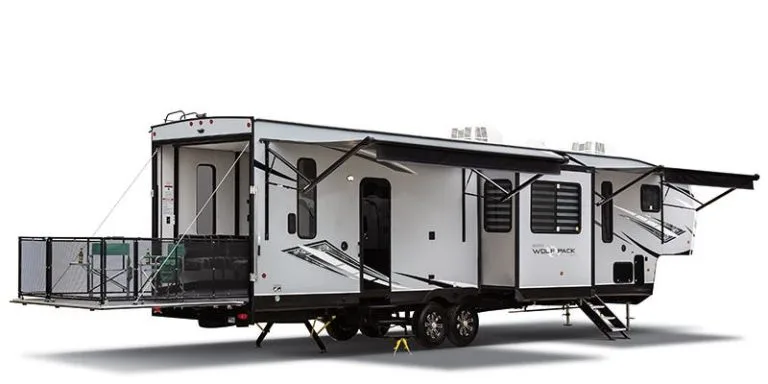
Toy Haulers are popular with people with lots of toys like motorcycles, jet skis, and ATVS. because they are built with a garage area to carry them. The garages often convert to living areas and have lots of storage space.
Toy Haulers vary in length from 15 – 48 feet, and can weigh anywhere between 3,600 to over 10,000 lbs when empty. Given this huge range in size, there is also a range in the towing capacity your vehicle will need to tow these RVs. And, given the variations in size and specifications, price can vary quite a bit as well. Cost can be as low as $20,000 and as high as $100,000.
Pros of Toy Haulers:
- Toy Haulers have cargo space with rear garage areas and ramps that can be easily used to transport gear and vehicles like motorcycles, ATVS, bikes, and jet skis. Basically, all your toys.
- The garage space can often be converted into additional living space when not in use for storage. The furniture in the garage area is designed to be versatile, such as fold-up sofas and drop-down beds.
- Toy Haulers typically have spacious living areas with full kitchens, bathrooms, and comfortable sleeping areas.
- They are built to be durable and can often have heartier construction than your typical travel trailer or motorhome.
Cons of Toy Haulers:
- Toy Haulers are usually heavier and larger than travel trailers, so you will need a more heavy duty tow vehicle.
- Their length will limit the number of campsites you can access.
- Toy haulers are often more expensive than travel trailers and fifth wheels due to their dual-purpose design and heavy-duty construction. This could also lead to higher maintenance costs.
The Toy Hauler I toured, Cherokee Wolf Pack, prides itself on being both affordable and versatile. The space converts quickly and easily from a garage for your toys to a living space with beds, a table and more. And the back ramp can easily convert to a patio deck once you have it unloaded.
In the front of the toy hauler there is a queen bed, a bathroom, kitchen, sofa/theater seating, and more storage. It is a nice combination of convertable spaces for your gear and comfortable living.
The Cherokee Wolf Pack is sold by Forest River. Prices are in the $80,000 range.
Class A Motorhome
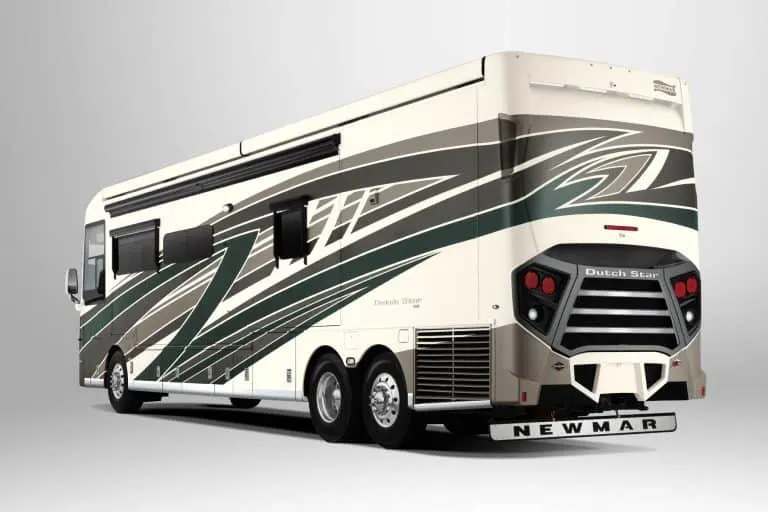
Class A motorhomes are usually the grandaddy’s of RVs. They are typically 22-45 feet in length and can start at $150,00 and top out at over one million dollars! Many Class A motorhomes look like tour buses.
These big boys are not the most fuel efficient so most people do haul a car behind them for easy travel once they reach their destination. Many Class A motorhomes sleep 6-8 people which is great if you have a big group.
These motorhomes often have slide outs which are electronically operate to widen the space inside the vehicle once you arrive at your campsite. This is the model you go for if space and luxury are your priorities.
Pros of a Class A Motorhome:
- Class A motorhomes offer the most living space, with large interiors, high ceilings, and multiple slide-outs that expand the living area.
- They often come with luxurious amenities such as full-sized kitchens, residential-style bathrooms, king-sized beds, and entertainment systems. Everything is self-contained.
- There is plenty of storage both inside and in the undercarriage compartments.
- They have powerful engines which allows them to tow vehicles.
- hey have larger fuel and water tanks, allowing for longer trips without the need to refuel or refill frequently.
Cons of a Class A Motorhome:
- They are usually the most expensive type of RV to purchase.
- Maintenance and fuel costs are higher for these RVs than others.
- Their large size can make driving and maneuvering in tight spaces challenging, especially for those new to RVing. They will also fit in fewer campsites and are banned from certain roads.
- They are not fuel-efficient vehicles- Class A motorhomes typically average 6-10 miles per gallon.
The Class A Diesel Coach Camper that I checked out was the Newmar Dutch Star. Newmar is under the Winnebago umbrella of brands and the Dutch Star is the best-selling Class A diesel motorhome on the market. They offer 12 different floor plans and pricing begins at $550,000.
This big boy is 37 feet long, weighs 40,000, and is loaded with all the comforts of home. There primary bedroom has a king bed, and lots of wardrobe storage. There is a full bath and half bath, dinette, full kitchen, and even a fireplace! It can sleep up to six people.
Disclosure: The author was hosted at The RV Experience 2024 by Go RVing and the RV Industry Association in order to learn more about the RV industry and share it with Trekaroo readers. All opinions are her own.
- Over 50 Fun Things to Do in Florida with Family on Vacation - April 9, 2025
- Uncruise Alaska- The Ultimate Small Ship Alaska Cruise for Families - April 9, 2025
- The 10 Best Maui Resorts for Families - April 11, 2025

